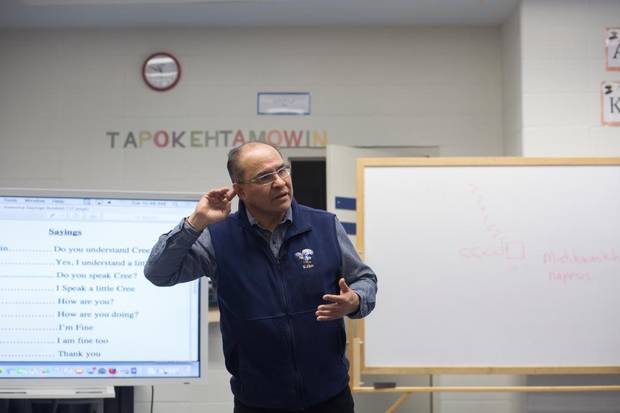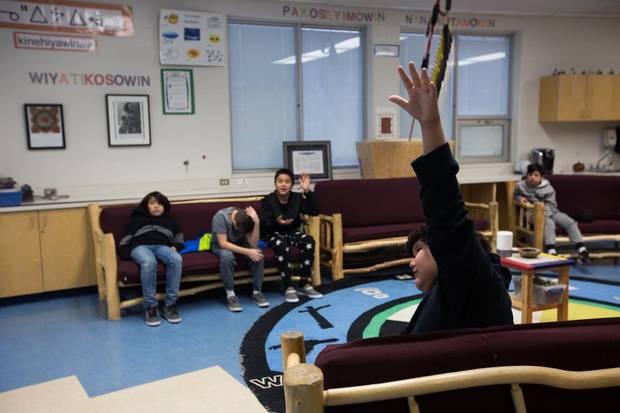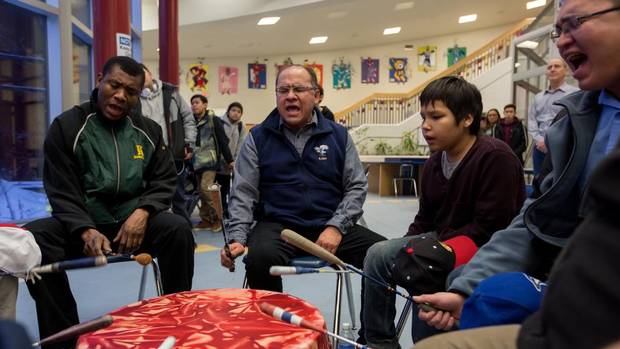When Stephen Wood was a child, an elder gave him the Cree name "Mistikwaskihk Napesis" during a traditional sweat ceremony in Arizona. Translated into English, the phrase means "Drum Boy."
"I often wonder how the heck the old guy that gave me the name knew I would end up being the keeper of drums," Mr. Wood says today.
He is 56 and has played the drum most of his life. He grew up in Alberta on the Saddle Lake Cree Nation, where his father, Alexander, conducted powwows. It was not unusual for visitors to drop by their house for a feast prepared by Mr. Wood's mother, Elsie. Afterward, they would play drums and sing.
"It was magic," Mr. Wood says.
He learned to speak Cree by listening to his parents and grandparents, and in 1982 formed a drumming and singing group called Northern Cree as a means to celebrate his heritage.
The group is so talented that it was nominated for a Grammy Award six times between 2002 and 2011, and received a seventh nomination this year. On Sunday, Northern Cree is vying for an award for the best regional roots album against a Hawaiian singer/songwriter and three ensembles specializing in Louisiana Cajun and Zydeco music. Previously, Northern Cree was nominated for best native-music album, a category that was discontinued in 2012.
"This one is special," Mr. Wood says between classes on the Erminskine Cree Nation, a reserve about an hour's drive south of Edmonton where he is a native-language teacher. Ermineskin is one of four nations in the community that makes up Maskwacis.
I thought the possibility of us getting there with our style of music was slim and none. I never thought we would go back again," Mr. Wood says.
The group has never won the Grammy, but has been asked this year to perform during the program in Los Angeles for the first time. They will be the opening act, playing in the afternoon, with their performance live-streamed to millions of viewers. Beyoncé, Adele and Justin Bieber will perform during the evening telecast, which drew 25 million viewers a year ago. "It is the first time powwow music will grace that stage," Mr. Wood says. "We are not just representing our communities and our tribe but all First Nations people, and beyond that, people from Alberta and Canada.
"It is something we don't take lightly," Mr. Wood says.
The group, which has released 37 albums over 35 years, has created music for and was featured in the 1999 biopic Grey Owl directed by the late Sir Richard Attenborough.
The 16 band members come from the Ermineskin, Saddle Lake, Samson Cree, Louis Bull, Frog Lake and Sunchild First Nations in Alberta, and the Onion Lake, Poundmaker and Sweetgrass Nations in Saskatchewan.
Members are university students and working professionals, and because of those demands, they have only limited time to rehearse. From June through September, they play as many as 50 engagements each year. After that, they entertain at selected weekend bookings across Canada and the United States.
"It is more than just me," Mr. Wood says. "So many people play a big part, and have brought the group this far."
A lesson in language
Dreams are born and grow at Ermineskin Junior and Senior High, which was opened in 2002 on the former site of one of Canada's largest residential schools. A sign in English and Cree greets visitors near the entrance, and the smell of sacred herbs burned in smudge pots permeates the air.
There are 325 students in Grades 7 through 12, and another 640 in the adjacent kindergarten and elementary school. The community has been blemished by drugs, gangs and violence, but is not without hope.

Stephen Wood teaches his Cree language class at Ermineskin Junior Senior High School in Maskwacis, Alta.
Amber Bracken/For The Globe and Mail
Mr. Wood has been the Cree teacher for 31/2 years. He teaches three classes a day with students seated around him on couches. At their feet, there is a colourful carpet decorated with bison, bears, beavers and wolves. His classroom is a haven for students seeking to learn more about their culture.
"The first thing I did was get rid of the desks," Mr. Wood says. "Mine is an unorthodox classroom. We don't do a lot of writing. We do a lot of speaking."
He tells his students: "If you understand who you are and where you come from, that is the most important thing … The Creator made you for a reason. You all have a gift. All you have to do is find it. That culminates in making Mother Earth a better place."
School buses aren't operating this morning because temperatures have dipped below –30, so attendance is sparser than usual. Students eat breakfast until they are interrupted by the sound of drums.
Led by Mr. Wood, a circle of students and staff begin thumping their instruments. Haunting chants in Cree are followed by morning prayers, after which students head to class, drums echoing through the hallways.
"I am 56 years old, and hard-pressed to find anybody in the community I can speak Cree with," Mr. Wood laments as he begins to teach his first of three classes for the day.
At the school, Cree lessons are mandatory in seventh through ninth grades, and optional beginning in Grade 10. Even though students can take another course, Mr. Wood's Cree class remains the most popular at the school. In the last few years, a native dance troupe has emerged, a drama club has been started and a course in Cree has been offered to staff.

A Cree class at Ermineskin Junior Senior High School.
Amber Bracken/For The Globe and Mail
"We felt we needed to create an environment where students are comfortable," Keith MacQuarrie, the principal, says. He is a white man from Cape Breton but speaks fluently enough to make announcements in Cree. "We want our students to be proud of who they are."
When he was a kid, Mr. Wood was among 150,000 aboriginal youths forced to attend residential schools. He remembers being rapped on the head by a teacher the first time he spoke Cree in residential school. Even today, he says, parents and grandparents of aboriginal children hesitate to send them to school because of the abuses that were inflicted upon them.
"It is going to be a long battle to get students to learn our language, but there is a hunger there," Mr. Wood says. "They want to know who they are.
"My goal is that, in three years' time, the valedictorian will get on stage and address everyone in Cree. For a lot of older people, there will be tears of joy."
'It is all created from inside here'
At the end of the day, Mr. Wood goes home to his wife, Hilda Omeasoo. Omeasoo means "the beautiful one" in Cree, and Ms. Wood is not one to argue.
He was 15 when he saw Hilda for the first time. He was playing hockey in a tournament and she was there, rooting for her boyfriend, who played for a different team.
"I was in love with her before she even knew I existed," Mr. Wood says. When she walked by, he told his friends, "There is my wife."
It wasn't until years later, when he returned to the Ermineskin Nation, where he'd moved during high school, on a break from studies toward his education degree at the University of Saskatchewan, that he bumped into Hilda again. They have been married 33 years, and have two children and two grandkids. His daughter, a teacher at the school, belongs to the dance troupe.
When he feels troubled, Mr. Wood retires to a room in his house that is full of drums and other musical instruments. He sits in a rocking chair collecting his thoughts, and smudges, a traditional native ritual.
"I am going to tell you about the power of the drum," he says. "I have had people standing five and six deep around me, and have seen thousands of people of different ethnicities with tears in their eyes.
"When they hear it, their financial worries, mental issues and emotional upset are gone. At the end, I am soaked in sweat and feel spent."
Northern Cree entertained last fall during inaugural ceremonies at Rogers Place, the new home rink for the Edmonton Oilers. In 2013, they opened for the Tragically Hip at a Canada Day concert in London. Fifty-thousand people jammed Trafalgar Square.
"The crowd was huge," Mr. Wood says. "My hands were sweating."
There is no written music when the band plays. One member starts, and then, one by one, others join in.
"There are 1,000 ceremonial songs within a person's being," Mr. Wood says. "There is a connection between all of the people in the group. What's unique about it is that when we all sing, it sounds like one voice."
He taps his chest: "It is all created from inside here."
A gift to share
During a previous trip to the Grammys, Mr. Wood chatted up Lil Wayne as they waited for an elevator at the Staples Centre. At an after-party once, members of Northern Cree were approached by a young woman curious about their beaded vests. It wasn't until later that Mr. Wood realized it was Britney Spears.
Another time, after performing at the Kodak Theater on Hollywood Boulevard, the group received an invitation from Jay Leno to watch a taping of The Tonight Show. A limousine picked them up the next morning and whisked them to NBC, where they received a studio tour and visited in the Green Room with Chris Rock.
"I am thankful for the places I have been and the people I have met," Mr. Wood says. "The drum took me there. It is a gift I have and I want to share."
If Northern Cree wins the Grammy on Sunday, Mr. Wood says he will bring it to schools for indigenous youths to see.
"Each time I go, I think about what I am going to say if we are called up," he says. "It would be overwhelming.
"It would send a message that you don't have to try to be anyone else, that anything can happen if you embrace your language and culture.
"We want kids to see that."
MORE FROM THE GLOBE AND MAIL:
